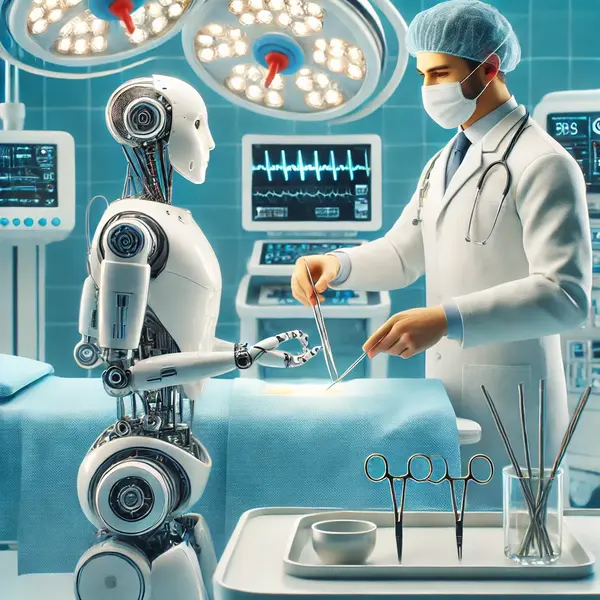In recent years, robotics has emerged as one of the most transformative forces in healthcare and medicine. From precision surgeries to personalized patient care, robots are reshaping the way medical professionals diagnose, treat, and support patients. Let’s dive into the fascinating world of medical robotics and explore how they’re revolutionizing the healthcare industry.
1. Robotics in Surgery
One of the most prominent applications of robotics in healthcare is in the operating room. Robotic surgical systems, such as the da Vinci Surgical System, are enabling surgeons to perform complex procedures with unparalleled precision. These robots provide high-definition 3D visualization, enhanced dexterity, and steady movements, reducing the risks associated with human error.
For example, minimally invasive robotic surgeries lead to smaller incisions, less blood loss, and faster recovery times for patients. Procedures like prostatectomies, heart surgeries, and even orthopedic surgeries are being revolutionized by these advanced tools.
2. Rehabilitation Robotics
Robots are playing a vital role in helping patients regain mobility and independence after injuries or surgeries. Robotic exoskeletons, such as those developed by companies like Ekso Bionics, assist patients with spinal cord injuries or strokes to walk again. These devices provide physical support and real-time feedback, accelerating rehabilitation and boosting patient confidence.
Robotic therapy tools are also being used in physical therapy clinics, where they help patients rebuild strength and coordination through guided, repetitive movements tailored to their needs.
3. Robotic Assistants for Patient Care
Beyond the operating room, robots are assisting with everyday patient care. Robotic nurses, like Moxi, are designed to handle routine tasks such as delivering supplies, fetching medications, and even assisting with patient mobility. These robots help reduce the workload of healthcare staff, allowing them to focus on direct patient care.
For elderly or disabled patients, companion robots like Paro (a therapeutic robot seal) provide emotional support and companionship. These robots are particularly valuable in addressing loneliness and improving mental well-being.
4. Medical Imaging and Diagnostics
Robotics is also enhancing the accuracy and efficiency of medical imaging and diagnostics. Robotic arms are being used to position imaging devices with extreme precision, resulting in clearer images and more accurate diagnoses. In some cases, AI-powered robotic systems can analyze scans and detect anomalies faster than human radiologists, enabling early detection of diseases like cancer.
5. Drug Delivery and Microbots
Imagine a tiny robot delivering medicine directly to a tumor inside the body. This is no longer science fiction but a reality in the making. Microbots, microscopic robotic devices, are being developed to navigate through the bloodstream and deliver drugs to specific locations in the body. This technology has the potential to revolutionize treatments for cancer, cardiovascular diseases, and more by minimizing side effects and maximizing effectiveness.
6. Automation in Hospitals
Robotics is streamlining hospital operations through automation. Autonomous robots are being used to disinfect rooms, transport medical supplies, and even prepare medications in pharmacies. These robots ensure a sterile environment, reduce the risk of infection, and improve overall efficiency in healthcare facilities.
7. The Challenges Ahead
While robotics is transforming healthcare, there are challenges to overcome. High costs of robotic systems can limit accessibility, particularly in developing countries. Additionally, healthcare professionals need specialized training to operate these advanced systems effectively. Ethical concerns, such as patient privacy and the potential over-reliance on robots, also need to be addressed.
8. The Future of Robotics in Medicine
The future of medical robotics is incredibly promising. As technology advances, we can expect robots to become more affordable, intuitive, and versatile. Innovations such as AI integration, advanced sensors, and machine learning will further enhance the capabilities of medical robots, making them indispensable in healthcare.
In the coming years, we may see robots taking on roles we never thought possible, from performing autonomous surgeries to providing real-time health monitoring through wearable robotic devices.
Conclusion
Robotics is undeniably transforming the healthcare landscape, improving patient outcomes, and redefining how medical professionals deliver care. As this technology continues to evolve, it holds the potential to make healthcare more efficient, accessible, and personalized than ever before.
The fusion of robotics and medicine is not just a technological advancement—it’s a testament to human ingenuity and our relentless pursuit of better health for all.
